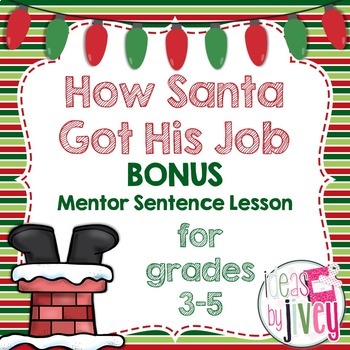
This time of year, it’s no secret that most kids have Santa on the brain…
…so don’t fight that feeling! You definitely can’t beat ’em on this one, so join ’em!
Since it can get tricky to keep students’ learning stamina going this time of year, incorporate fun mentor texts to keep them excited about the season WHILE learning! Of course, they can be used as fun read-alouds, but they can also be implemented for reading, writing, and language standards.
The two mentor texts I’ll be highlighting in this post are by Stephen Krensky:


The book links in this post are affiliate links. It doesn’t cost you anything extra to purchase using my links, and Amazon gives me a few cents per purchase which I use to fund awesome giveaways for teachers!
There is so much that can be done with these two books. Your ELA lessons will be covered for at least a week!

In the first book of the two, How Santa Got His Job, we learn how Santa’s skills led him to his dream job! Students can work on citing specific text evidence to share Santa’s skills, and ultimately why each job didn’t really work out for him.
In the second book, How Santa Lost His Job, a machine is invented to deliver gifts more efficiently, but it causes many problems, too. Students can easily compare Santa to “The Deliverator” to show how a human with love and compassion is always better than a machine.
Both books are excellent for reviewing cause and effect! Not only can you work on identifying causes and effects within the text, but it’s also helpful to work on creating complete sentences containing both the cause and effect.

If you share the cause first, use the word “so” to connect it to the effect.
“Santa tasted and sampled the food, so he gained a lot of weight.”
If you share the effect first, use the word “because” to connect it to the cause.
“Santa lost the contest because he took time to carefully read each letter and match kids to gifts.”
You can also “flip” the clauses, putting the dependent clause first!
“Because Santa took time to carefully read each letter and match kids to gifts, he lost the contest.”
These mentor texts are great examples to use for student writing! In How Santa Got His Job, Stephen Krensky did a great job explaining the skills of many jobs that Santa had. Students could brainstorm the skills that elves need and write their own story about an elf being hired, the way that the author did about Santa.
In How Santa Lost His Job, a substitute for Santa was designed. Students could write an informative paragraph about the kind of skills a substitute would need, perhaps drawing on the failings of “The Deliverator” to make sure a substitute would have the right qualities.
Stephen Krensky used a variety of sentence types, as we would want our students to do, so using mentor sentences to demonstrate sentence variety is a great teaching tool! I have a free BONUS mentor sentence lesson for How Santa Got His Job, which focuses on compound sentences.

You can also point out the differences from other sentences in the text that use compound subjects and compound predicates, and identify those as simple sentences compared to compound sentences also found in the text.

Finally, How Santa Lost His Job is full of dialogue between the elves and Santa. Stephen Krensky is a great mentor for using synonyms for said throughout the text. Some ideas for practice would be to have students use quotation marks, as well as use vivid verbs to replace the word “said” in the tags within dialogue.

You can find all of these activities (and more) in this seasonal Santa’s Jobs mentor text unit!

PIN FOR LATER:
